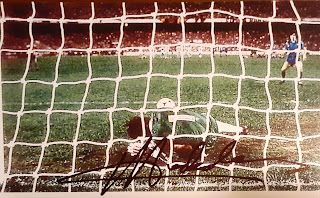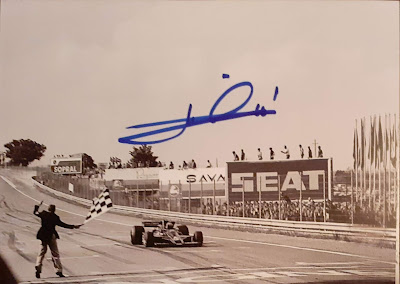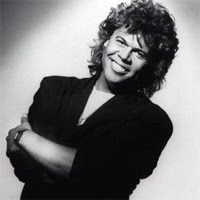Taco Ockerse (born July 21, 1955), better known by his stage name
Taco, is an Indonesian-born Dutch singer
and entertainer who started his career in Germany.

Taco Ockerse born in Jakarta, Indonesia on July 21, 1955,
has spent many of his childhood years moving around the world residing in the Netherlands, the United States, Singapore, Luxembourg, Belgium and Germany.
He attended the International School of Brussels, Belgium, and graduated in 1973. Afterward, he studied interior decoration and finished acting school in Hamburg. He held lead roles in numerous school productions, including
You're a Good Man, Charlie Brown,
Carousel,
The Fantasticks, and
Fiddler on the Roof.
In 1975, he began his first professional theatrical engagements in Hamburg.
This included roles in
Children's Theater, and roles as an ensemble member of the Thalia Theater in a number of plays, including
Sweet Charity,
Chicago, and
Three Musketeers. He also directed and choreographed for the musical
Nightchild. In 1979, he played "Chino" in John Neumeier's
West Side Story at Hamburg Opera House. He founded his first band, Taco's Bizz, in 1979.
In 1981, Taco signed his first record contract with
Polydor (Germany) for two record releases, whereon he released his first single, "
Puttin' on the Ritz".
Not long after, in 1982, his single, "Puttin' on the Ritz" was picked up by
RCA for US release. The single was widely played throughout the U.S. by late summer of 1983 eventually peaking at no. 4 in September, 1983 on the
Billboard Hot 100 as well as no. 1 on the
Cashbox charts.
Although the single eventually earned him a Gold-certification in USA for selling over one million copies, it was Taco's only top-40 hit in the U.S.
Between 1983 and 1984, he performed extensive touring throughout
Europe. While the single "Puttin' on the Ritz" topped the charts in Sweden and New Zealand, it entered the Top-5 in numerous countries including Norway, Austria and Canada.
His subsequent album release of
After Eight was released in over 40 countries and managed to reach no. 4 in Norway, no. 5 in Canada, no. 11 in Austria, no. 17 in New Zealand and no. 23 in U.S. and no. 59 in Germany.
The album earned Taco number of Gold certifications including one in Finland for selling over 25,000 copies.
Taco's second single "Singing in the Rain" was only a moderate success peaking at No. 49 in Germany and No.46 in Canada.
He appeared as a guest on
The Bob Hope Show,
The Merv Griffin Show,
Alan Thicke,
Solid Gold,
Good Morning America, and many other TV shows while touring.
Taco's follow-up album,
Let's Face the Music was recorded in 1984 for Polydor (Germany) which peaked at no. 58 at his home of Germany and managed to enter the top-100 in Canada peaking at no. 92.
Taco continued to record, focusing mostly on the German market with albums
Swing Classics/In the Mood of Glenn Miller in 1985 and
Tell Me That You Like It in 1986 for
Polydor. In 1987 he recorded the self-titled album
Taco.
In 1989 he briefly flirted with contemporary dance music by releasing a pair of singles, "Love Touch" and "Got to Be Your Lover", that were styled after the high energy disco sound popularized by
Stock Aitken Waterman. Afterwards, he repositioned himself as a swing/soul singer. He has collaborated with Geff Harrison of
Kin Ping Meh fame.

Between 1989 to 1996, Taco worked intensively as an actor. He had television acting roles in
Friedrichstadt Palast and
Das Erbe der Guldenburgs, and an appearance in the film
Karniggels. He also appeared as "Chico" in the theater production of
Marx Brothers Radio Show, and played lead roles in
Shakespeare Rock n Roll in Berlin and
Shakespeare as We Like It in Austria.
He currently resides in Germany, performing with his band and as a gala artist.
On October 11, 2009 the first channel of Russian TV, 1TV, filmed the program
Songs of the 20th Century. Taco appears with "Puttin' on the Ritz" in the sequence about the 1930s. The show was broadcast in January 2010. On November 27, 2009 he performed "Puttin' on the Ritz" and "Singin' in the Rain" at the Olympic Stadium in Moscow, Russia. Furthermore, he was the star guest in the "New Year's Eve Show 2009" of Russian TV, which had about 84 million viewers in more than 20 countries.
In July 2010 Cleopatra Records - Los Angeles released an entirely new re-recording of "Puttin' on the Ritz". Taco's vocals were recorded in Germany and the backing tracks with top studio musicians in their studio in L.A.
On March 1, 2011 DingDing Music released the original song "Timeless Love" that was written and produced by Edgar Rothermich and Matthias Muentefering in the late 1980s. The studio recording that Taco performed as a duet with the female singer Rozaa Wortham in Berlin was remixed in late 2010 in the U.S. and is now available for download.
 Iohannis was elected the mayor of the city of Sibiu
in 2000, representing the Democratic Forum of Germans in Romania.
Although the German population of the once predominantly German-speaking
city of Sibiu (German: Hermannstadt, Transylvanian Saxon dialect: Härmeschtat)
had declined to a tiny minority, Iohannis won a surprise victory and
was re-elected by landslides in 2004, 2008, and 2012. Iohannis is
credited with turning his city into one of Romania's most popular
tourist destinations, and the city was declared the European Capital of Culture in 2007. In February 2013, Iohannis became a member of the National Liberal Party, accepting an invitation from then liberal leader Crin Antonescu, and was immediately elected the party's First Vice President, eventually becoming the PNL President during the following year.
Iohannis was elected the mayor of the city of Sibiu
in 2000, representing the Democratic Forum of Germans in Romania.
Although the German population of the once predominantly German-speaking
city of Sibiu (German: Hermannstadt, Transylvanian Saxon dialect: Härmeschtat)
had declined to a tiny minority, Iohannis won a surprise victory and
was re-elected by landslides in 2004, 2008, and 2012. Iohannis is
credited with turning his city into one of Romania's most popular
tourist destinations, and the city was declared the European Capital of Culture in 2007. In February 2013, Iohannis became a member of the National Liberal Party, accepting an invitation from then liberal leader Crin Antonescu, and was immediately elected the party's First Vice President, eventually becoming the PNL President during the following year.














